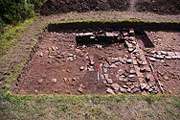An excavation trench across Caerleon's quayside wall, wharves and jetties
The remains of a 2000-year-old Roman port have been discovered in south Wales by archaeologists from the University.
Uncovered outside the Roman fortress in Caerleon by a team of staff and students from the School of History, Archaeology and Religion, the port is only the second known from Roman Britain and sheds new light on Wales’ role in Roman Britain.
The well-preserved remains of the port are located on the banks of the River Usk just north of the city of Newport and include the main quay wall, as well as the landing stages and wharves where ships would have docked and unloaded their cargoes. The team made the find during their on-going excavations of the ‘Lost City of the Legion’, an unknown suburb of very large public-style buildings discovered by the University last year.
Along with the port, the archaeologists’ trenches have produced some remarkable finds, including the remains of several monumental buildings that perhaps include marketplaces, administrative buildings, bath-houses and temples. It is the first time that these remains have been seen in almost two millennia.
Dr. Peter Guest, Senior Lecturer in Roman Archaeology who is leading the Cardiff excavation team said: "What we have found exceeds all expectations. We are excavating the remains of a previously unknown complex of important Roman buildings that survive remarkably well considering how long they have lain underground.
"The port or harbor is a major addition to the archaeology of Roman Britain and adds a new dimension to our understanding of Caerleon as we can start to think about how the river connected the fortress and Wales to the rest of the Roman Empire. We believe that the port dates to period when the Legions were fighting and subduing the native tribes in western Britain and it’s incredible to think that this is the place where the men who took part in the conquest would have arrived.
"Our trenches are also looking at several buildings adjacent to the port and we have also found rooms with under floor heating systems, collapsed walls and roofs, as well as many thousands of objects made, used and lost during the Roman period. We have just over a week to go until the excavation ends and it will be exciting to see what new discoveries the next few days bring."
Known as Isca, the fortress at Caerleon was constructed in AD 74/5 during the final conquest by the Roman army of the fierce Celtic tribes in South Wales. It was the headquarters of the Second Augustan Legion – one of four legions who invaded Britain during the reign of the Emperor Claudius.
The dig runs until 1st September and is open to the public with special tours of the site at 11.00am and 2.30pm daily (except Wednesday). During the August bank holiday weekend (27th-29th, 10 am to 4.30 pm) there will be tours, displays of the latest finds and lots of activities for families to join in – including dressing up as Romans, making pots and sampling Roman cooking.
More information: You can follow the archaeologists’ progress on the Dig Blog at: www.britarch.ac.uk/caf/wikka.php?
Provided by Cardiff University





















